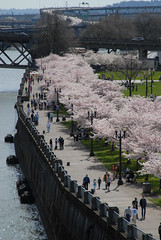Early last Friday morning, a man was kicked out of Waterfront Park for 30 days by a Portland Police officer because he was riding in the park at 4:30 am (the park is closed from midnight to 5 a.m.). The incident has sparked an interesting debate about how the Portland Parks Bureau deals with park facilities that have paths used as transportation corridors within their boundaries.
Unlike other popular multi-use paths that are inside Parks-managed properties (like the Eastbank Esplanade and the Springwater Corridor), the path that runs through Waterfront Park is not technically considered a transportation corridor. The official reason is because it was not funded with federal transportation dollars (the two examples above were funded through the FHWA’s Transportation Enhancement grant program).
On Friday, I had a conversation with Portland Parks Public Information Officer Beth Sorensen (unfortunately, Parks’ Public Safety Manager Mark Warrington, is on vacation). Sorensen confirmed for me that because the path was not a designated transportation corridor, the park closure hours, 12:01 a.m. to 5:00 a.m. apply to people using the path.
“The federal government, it seems, has higher standards for multi-use trails than Portland does.”
— From a blog post by the BTA
However, even though the park is closed, Sorensen added that people biking through the park would not be cited for trespassing unless there was an “incident” (which I take to mean some sort of interaction/altercation between two people — especially if one of them happens to be a police officer). She also noted that “viable alternatives” exist on SW Naito Parkway (which has bike lanes and sidewalks).
According to Sorensen, the issue comes down to a lack of enforcement capacity. To help me understand, she offered an analogy: “We don’t have the capacity to enforce the off-leash dog rules. It’s only when it becomes an incident — like when a dog is aggressive or they mow down children — that we can enforce that.”
I pointed out to Sorensen that the idea of maintaining transportation access through a park at all hours was perhaps a bit more important than playing catch with Fido, and as such, the issue might deserve a more formal policy change.

Red: connection from Naito to Steel Bridge deck
Purple: Waterfront Park path
Adding urgency to the Waterfront Park situation is that, even with bike lanes on Naito Parkway, the lower deck of the Steel Bridge (which is a federally-funded transportation corridor) is technically closed off for five hours a day because it can only be accessed via the Waterfont Park path. Sorensen said she’d take that feedback “under advisement” and she seemed open to further discussions (that might include granting an easement from Naito to the Steel Bridge deck — see graphic at right).
The case of the man being formally excluded from Waterfront Park is unfortunate, but the larger issue here is how the Parks Bureau deals with biking and walking traffic through their facilities.
Carl Larson of the Bicycle Transportation Alliance (he’s recently began to represent them on advocacy issues in addition to his role as a kid’s Bike Safety Educator) weighed in on this issue Friday night. Larson had strong words for Portland Parks that could foreshadow more formal discussions — and perhaps a policy change — in the future.
Here’s an excerpt (emphasis mine):
“The BTA feels strongly that safe, direct, and popular transportation routes through our cities should remain open and legal to pass through at all times. Waterfront Park, just like the Eastbank Esplanade, the Springwater Corridor, and 82nd Avenue, is an important transportation corridor. Unfortunately, unlike the latter three, Waterfront Park is not required to remain open because it was not built with federal transportation dollars. The federal government, it seems, has higher standards for multi-use trails than Portland does.”
The BTA urges the Parks Bureau to officially recognize that paths “like those through Waterfront Park, Laurelhurst Park, Gabriel Park, and Irving Park… aren’t just for daytime strolling” (it’s worth noting that this issue was already on the radar of former BTA executive director Scott Bricker).
Given that City Parks Commissioner Nick Fish understands bicycle transportation and has proven to be open and sensitive to the topic, I wouldn’t be surprised if we see some movement on this issue. Stay tuned.


